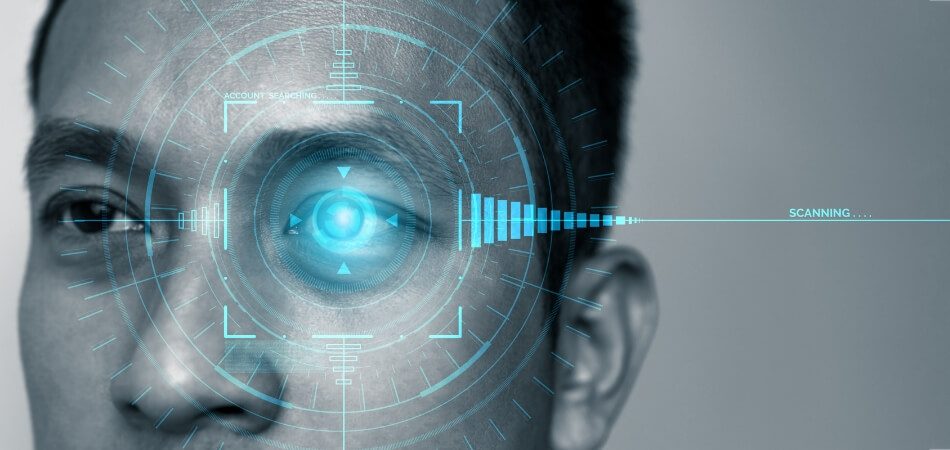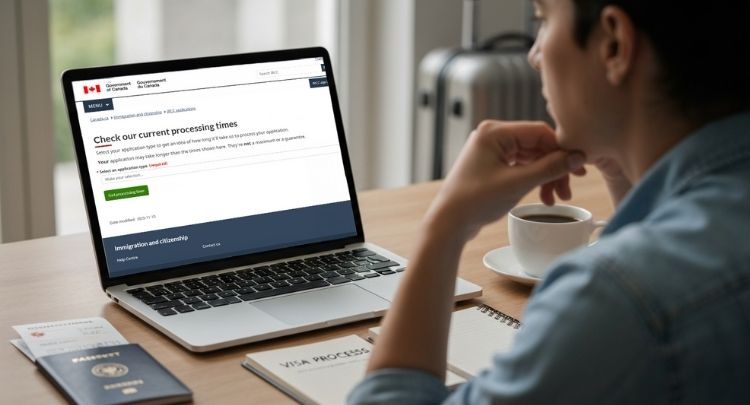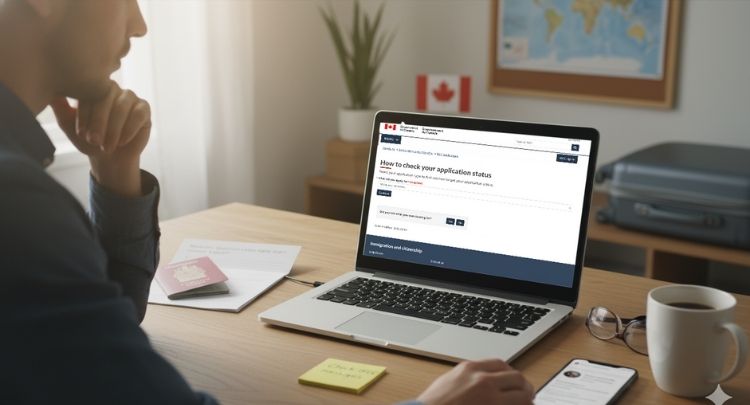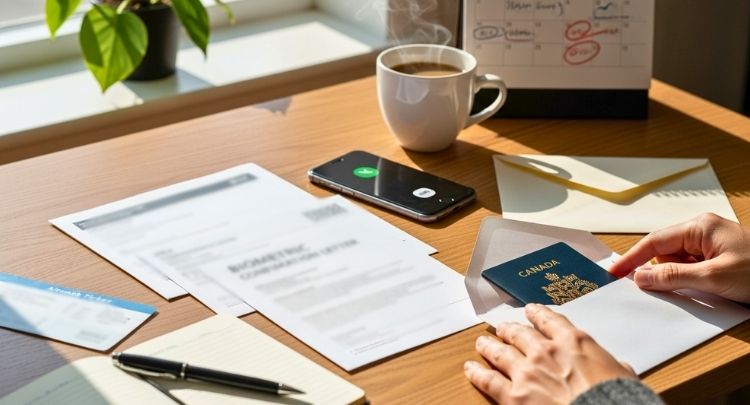Biometrics include your fingerprints and photo, and IRCC collects them to confirm your identity in a safe and simple way. Once this step is done, many people start to think about the next part of the process, which leads to the question what is the next step after biometrics for Canada visa?
After biometrics, IRCC links them to your application, checks your documents, and begins eligibility and background reviews. A medical exam may be assessed if required. Once all checks are done, IRCC makes a final decision and may request your passport.
Are you curious about each stage in this process and how long it might take? Keep reading this article because it explains every important step clearly so you can understand what happens and what you should expect next.
What is the Next Step After Biometrics for Canada Visa?
After you finish giving your biometrics, your Canada visa process keeps moving forward. The immigration office starts checking your application step by step. They go through your papers, background, and health details before giving a final answer. Let’s look below to understand what really happens after biometrics.
Biometrics Linked to Your File
Once you give your fingerprints and photo, they are saved and safely sent to IRCC. These are connected to your visa file. You do not need to do anything here. If you want to check updates or details, you can visit the official IRCC biometrics page for clear and latest information.
Completeness Check
This part makes sure you have given all needed forms and papers. IRCC checks if your documents match the visa type you applied for. If anything is missing, your file may be returned. This step can take a few weeks, and you will see “Application under review” in your account.
Common Reasons Files Fail
Sometimes files are sent back because of missing pages or unsigned forms. Old documents, wrong formats, or unclear scans also cause trouble. It’s best to check everything twice before you apply. This small care can save you many weeks of delay.
Eligibility Review
At this stage, officers decide if you meet the visa rules. They check your purpose, work, studies, or travel plans. For example, if you’re planning to attend an international conference in Canada, your invitation letter and event details will be reviewed closely. When your account says “We are reviewing your eligibility,” it means they are deciding if you qualify.
Background and Security Check
Police and security teams check if you have any criminal record. They also look at your past travels and if you followed visa rules before. This part can take longer, especially if you lived in many countries. Your account may show “Background check in progress.”
Medical Exam Review
Some applicants need a health test from an approved doctor. When it says “Medical passed,” it means your health check was cleared. If the doctor finds anything unclear, IRCC may ask for more reports. Any delay in this stage can slow down your visa decision.
Review of Eligibility Status
If your eligibility looks good, the update changes to “Eligibility passed.” It means your documents and reasons for travel are accepted. Once this happens, most of your waiting time is for the final review. Stay calm and keep checking your account updates.
Final Review Before Decision
Before deciding, officers go through your full record again. They make sure everything meets Canadian law and visa rules. You may get a message for more papers if needed. Once everything looks fine, they move to the approval step.
Passport Request and Visa Decision
When IRCC approves your file, they send a passport request. You’ll need to mail or drop off your passport to get your visa stamp. This is the last step before you can travel for studies or work. After this, you can plan your tickets and stay.
After Decision Updates
Once your visa is approved, your account will show “Approved.” You’ll get an email about passport return or pickup details. If your visa is refused, the reason will be shared clearly. You can apply again after fixing the issues mentioned.
After biometrics, your Canada visa goes through many small checks. Each part matters to prove your identity, purpose, and background. The process may take time, but keeping your account updated helps you stay on track. Be patient and ready for any extra papers they might ask for.
Typical Timeline for Canadian Visa After Biometrics
The waiting period after giving biometrics can feel a bit long. Each week brings you closer to the final decision on your visa. The steps move in a set order and take time to finish. Let’s look below to see what usually happens week by week.
Week 1 to Week 2: Biometrics Update and Checks
After you finish your biometrics, IRCC links your fingerprints and photo to your file. They confirm your identity and mark this step as complete. You may see “Biometrics received” in your online account. This part is usually fast and takes only a week or two to show up.
Week 3 to Week 4: Eligibility Review
Next, officers check your purpose for visiting or studying in Canada. They review your documents and proof of funds. If you have an invitation or admission letter, it helps move things faster. The Canadian visa processing system follows a specific order after biometrics, starting with eligibility review and moving to background checks before the final decision.
Week 4 to Week 8: Background and Security Checks
During this time, IRCC works with police and security agencies. They look at your travel history and make sure you have no criminal record. This step can take longer if you lived in many countries. You may see “Background check in progress” in your account during these weeks.
Week 6 to Week 12: Final Review and Decision
In the last part, your full file goes through a final review. IRCC checks everything again before making the decision. If all looks good, you’ll get a passport request soon. After this, your visa is either approved or refused based on the results of earlier checks.
The timeline after biometrics can vary based on your visa type. Some cases finish faster, while others take a few extra weeks. Keeping an eye on your account helps you stay updated. You can also check the latest updates using the official IRCC processing time tool to see how long it may take for your application.
Timeline Differences by Canadian Visa Type After Biometrics
Getting a Canadian visa can take different times based on your visa type. After you finish your biometrics, the waiting period starts. Some visas are processed faster, while others take longer because of extra checks. Let’s look at the normal timelines and what can delay each visa type below.
Visitor Visa (Tourist / Temporary Resident Visa)
If you’re applying to visit Canada for travel, family, or short-term stays, this is the visa you’ll need.
Average Timeline After Biometrics
- Most cases take about 1 to 4 weeks (roughly 7–30 days) to get a decision.
- Some may take 3–6 weeks, depending on the visa office and workload.
Why it Can Take Longer
- Missing or incomplete documents.
- Seasonal high demand (especially during holidays or travel seasons).
- Additional checks such as interviews, medical exams, or police certificates.
Study Permit (Student Visa)
This visa is for people planning to study in Canada at a college or university.
Average Timeline After Biometrics
- Usually processed in 4–10 weeks.
- Many applicants get results within 6–8 weeks on average.
Reasons for Delays
- Verification of school admission or academic documents.
- Missing financial proof or health exam results.
- Busy academic seasons (before semesters start) can slow processing.
Work Permit
If you plan to work in Canada, this permit lets you take up a job for a set time.
Average Timeline After Biometrics
- Normally takes about 6–10 weeks if the case is simple.
- Some may be approved sooner, especially if inside Canada or through fast-track programs.
Why it Might Take Longer
- Employer checks, LMIA (Labour Market Impact Assessment) or compliance verification.
- Complex cases, such as specialized jobs, overseas applicants, or extra background/medical checks.
- General backlogs or high volume of applications.
In short:
- Visitor visas are usually the fastest.
- Study permits take moderate time.
- Work permits often take the longest due to employer and labor market checks.
Every visa type follows a different path after biometrics. The more complete and correct your documents are, the faster you get results. Always apply early and double-check your papers before submission. Knowing what causes delays helps you plan better for your Canada trip or study.
What Do IRCC Officers Actually Do Behind the Scenes After Biometrics?
After you give your biometrics, your visa application goes through many careful checks by IRCC officers. They work behind the scenes to make sure every detail is right and that your information is complete and trustworthy.
- Document Verification: Officers carefully look through your submitted documents to confirm they are real, up to date, and match what you claimed in your application form.
- Background Screening: They review your travel and personal history to ensure there are no security or criminal concerns that could affect your visa decision.
- Cross-Checking Information: Officers compare the information you provided with other government databases to confirm accuracy and prevent mistakes or false details from being missed.
- Eligibility Assessment: They check if you meet the visa requirements, such as purpose of visit, finances, or admission to a recognized school or employer.
- Medical Review: If a medical exam is required, officers make sure your health report meets Canada’s safety standards before continuing with your application process.
- Workload Management: Visa offices handle thousands of applications, and officers must divide time carefully among them, which sometimes slows down decision-making.
- Quality Control: Supervisors or senior officers review random cases to ensure all decisions follow the right laws, steps, and fairness in every approval or refusal.
Even simple applications go through several steps that need careful checking. These reviews help Canada keep its immigration process fair, accurate, and safe for everyone who applies to visit, study, or work there.
How to Track Your Canadian Visa Application After Biometrics?
After you finish your biometrics, the next step is to keep an eye on your application progress. The easiest way to do that is through the IRCC application status guide, which explains how to check updates, what each status means, and where to find them in your online account.
If you used the older-style account (GCKey) or submitted online/paper applications, you can use it to see updates for your visa application. Here’s how you do it:
- Log in to your GCKey / IRCC secure account.
- Go to “View my submitted applications or profiles”, then click “Check status and messages” for your application.
- The account will show the latest status — whether your biometrics have been received, whether your application is in review, or if a decision has been made.
- If you applied by mail (paper application), you usually need to link that application to your online account before you can see status updates.
What The Status Info Means
- You may see stages like “Application received,” “Biometrics received,” “In progress,” and then “Decision made.”
- If there’s a missing document or required additional steps, IRCC will usually send a message via your account rather than by mail — so check messages regularly.
New IRCC Portal Improvements (2025–2026)
IRCC has been rolling out improvements to how applicants track status. These changes aim to make things clearer and faster. Here’s What’s changed:
- Status messages are more detailed and easier to understand when you log in.
- Updates tend to come sooner after each step (like biometrics or background check), so you’re less likely to wait long without seeing any change.
- For some applications, IRCC now sends updates through the portal instead of relying on email or mail — this means faster alerts if they need more info or have made a decision.
Myths and Facts About Post-Biometrics Processing for Canadian Visa
After giving biometrics, many people try to guess what happens next and how soon a decision will come. However, some common beliefs about this stage are not accurate. Here’s what’s actually true.
Myth 1: “Your visa will come in a few days after biometrics.”
This belief is false. Getting your visa a few days after biometrics almost never happens. Biometrics is just one of the early verification steps in the overall process. Once you provide your fingerprints and photo, your information is sent for identity confirmation and background checks.
After that, IRCC officers still need time to:
- Review your documents and forms.
- Verify your eligibility for the visa type you applied for.
- Complete security, background, and sometimes medical checks.
The time it takes after biometrics depends on the type of visa and where you apply from.
- Visitor visas may take about 1 to 4 weeks, sometimes longer.
- Study permits can take around 6 to 10 weeks.
- Work permits often take even longer because of extra employer or labour checks.
So while biometrics is an important step, it doesn’t speed up the process instantly. It simply moves your application to the next stage of review.
Myth 2: “If the background check is long, it means rejection.”
This myth is also false. A long background check does not signal rejection — it usually means the immigration office is being careful. Some applications need more time for verification, especially when the applicant has a complex background.
Here’s what can make background checks take longer:
- You’ve lived or worked in multiple countries.
- Your travel, education, or job history needs extra confirmation.
- The visa office is waiting for reports from other departments or international partners.
These checks are routine and don’t mean there’s a problem. Many applicants whose background checks take longer still receive visa approvals. The time spent only shows that IRCC is making sure all details are correct before making a final decision.
Both myths are false. Biometrics doesn’t mean an instant decision, and long background checks don’t mean refusal. The visa process continues step by step, and timelines vary depending on your case and the visa office handling it.
Common Reasons for Delays After Biometrics for Canadian Visa
After you finish giving your biometrics for a Canadian visa, you might notice your application takes longer than expected. Many people face small delays for simple reasons that are part of normal visa checks and document reviews.
- High Seasonal Applications: Many people apply at the same time during travel or study seasons, which makes visa offices busier and processing slightly slower than usual.
- Missing Documents: When required forms or proofs are not attached correctly, the visa officer must request them again, causing extra waiting time for review.
- Security Screening Hold: Some applications need additional safety checks. This step ensures that your identity and records match official systems before a final decision.
- Medical Result Delays: If a medical exam is required, results may take extra time to reach IRCC, especially if the clinic sends updates late.
- Background Information Mismatch: Small differences between your forms and official records can lead to extra checks to confirm details before approval.
- Workload at Visa Office: Different visa centers handle different volumes of applications. Some offices take longer due to higher workloads or fewer staff.
- System or Technical Updates: Occasionally, delays happen because of system maintenance or software updates in the online application portal used by IRCC.
A short delay after biometrics is normal and usually nothing to worry about. Keeping your documents correct, checking your account often, and staying patient are the best ways to avoid extra waiting time and keep your application smooth.
What Should You Do After Biometrics for a Canadian Visa?
After you finish giving your biometrics, your visa process keeps moving forward. It may take a few days for updates to show. You should keep checking your account to stay informed. Read below to know what steps help your process stay smooth.
Keep Checking Your IRCC Account
It is important to sign in to your IRCC account regularly. Updates about your file, messages, or requests appear there first. The system sometimes takes a few days to update after biometrics. Checking often helps you act quickly if IRCC asks for extra documents or information.
Prepare Your Passport for a Possible Request
Your passport might be needed for stamping once a decision is made. Keeping it ready helps you send it quickly if IRCC asks. Make sure it is valid for at least six months. If it is expiring soon, renew it before submission to avoid delays or extra steps.
Respond Fast to Any Document Request
Sometimes, IRCC may ask for missing or new documents. Replying quickly helps your file move faster to the next stage. If you delay your response, it can hold your process for weeks. Always check your messages and upload requested items through your IRCC account immediately.
Keep Your Email Active and Monitored
IRCC often sends messages or updates through email as well. It is good to check your inbox and junk folder every day. A missed email could mean a missed deadline. Staying alert ensures you never skip an important message about your application status.
Stay Patient While Waiting for Updates
After completing your biometrics, the next important step is waiting for updates from IRCC, which eventually lead to Canadian visa approval after biometrics if all your documents and eligibility checks are cleared. This waiting period can feel long, but it’s completely normal. Avoid checking too often or worrying too much if the status does not change right away.
Contact IRCC If You Face Long Delays
If there are no updates for many weeks, you can reach out. Use the official IRCC web form to ask about your case. They can confirm if your file is still active and in review. This is the best way to check for any system errors or pending steps.
Once you finish biometrics, your part is to stay ready and alert. Small steps like checking updates or keeping your passport valid help a lot. Stay calm if things move slowly; it is normal for visa cases. Keep following official channels for correct and safe updates.
FAQs About What is the Next Step After Biometrics for Canada Visa?
Many people get confused after giving biometrics and wonder what happens next. The waiting time can feel long, and updates may take time to appear. Each application goes through its own steps and checks. Below are some common questions and clear answers to help you understand the process better.
Why Does My Status Say “We Are Reviewing Your Eligibility” for Weeks?
This means IRCC is checking if you meet the visa rules for your type of application. Officers go through your papers, job details, or study plans carefully. The review can take time if they need to confirm any information. As long as you don’t get a document request, your file is still being processed normally.
What If I Already Gave Biometrics in the Past?
If you gave biometrics within the last ten years, you usually don’t need to give them again. IRCC will link your old biometrics to your new application. This helps save time and avoids repeating the same step. You can check your biometrics validity in your IRCC account to be sure.
Why Is My Background Check Taking Longer Than Others?
Background checks depend on your travel history and the countries you have lived in. If you stayed in many places or had different visas before, it may take more time. Security checks are done by several agencies, not just IRCC. Delays here are normal and don’t always mean a problem with your application.
What If IRCC Asks for More Documents?
When IRCC asks for extra papers, upload them as soon as you can. Follow the instructions in your account carefully. Don’t send anything that wasn’t requested, as it can slow down your file. Once IRCC gets the new papers, they continue your review from where it stopped.
Can I Speed Up My Application?
There’s no direct way to make your file go faster, but you can avoid delays. Make sure all your papers are clear, complete, and easy to read. Reply quickly if IRCC asks for more information. You can also check your expected time using the official IRCC processing time tool to know how long it usually takes.
What If My Medical Is Delayed or Expired?
If your medical report is late, IRCC will wait until the doctor sends it. Sometimes reports take longer to update in the system. If your medical expires before your visa is approved, IRCC may ask for a new exam. It’s best to finish the medical early so your visa decision doesn’t get delayed.
Conclusion
After completing biometrics, your visa process continues through several checks handled by IRCC. Officers verify your documents, review your background, and complete your medical and eligibility checks before making the final decision. Each step is important and takes time to ensure your details are correct and complete.
If you’re wondering what is the next step after biometrics for Canada visa?, it’s the review and verification phase done by IRCC. They carefully go through your papers, background history, and any required health tests before moving to the decision stage. Once everything is cleared, you’ll receive your final result or a passport request for visa stamping.
Stay patient and keep checking your IRCC account for updates or requests. Always upload documents correctly and respond quickly if asked for more details. Keep your passport valid, stay positive, and trust the process. Wishing you the very best for your Canada visa approval and a smooth journey ahead.










HI TEAM
I COMPLETED MY BIOMETRICS ON 01-12-2024 AND MY ELDER SON WILL COMPLETE HIS ON 26-12-2024.
WHEN CAN WE EXPECT TO RECEIVE THE MEDICAL REQUEST LETTER?
Once you’ve successfully completed your biometric, you will receive further instructions directly from the embassy where you applied. For status updates, visit their official website. Note that, a medical request letter is not required for conference visa applications.
Thank You
My name is FELIX EDOKU FLETCHER from GHANA West Africa
Pls i have submitted my biometric my wife and my child for almost ten (10)MONTH now.
No response was so ever.
What will be the possible COURSE?
Thank you for reaching out. We understand your concern regarding the delay in receiving a response after your biometric submission.
We recommend that you contact the embassy where you completed your biometrics for further updates on your application status. Also, regularly check the official online portal for any updates regarding your visa.
I completed My biometric collection on 2024.07.29 but still no reply to call next process
Hi, Sankeethan. Since you completed your biometrics on July 29, 2024, and it has been several months without an update (as of June 1, 2025), it’s best to log in to your IRCC account to check your application status. If nothing has changed, you can raise a case-specific enquiry through the official IRCC web form for clarification. There is no need to submit a new application unless IRCC instructs you to do so.